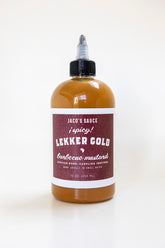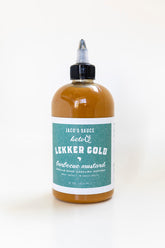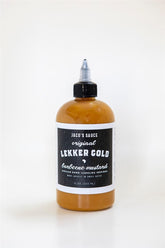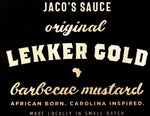Barbecue Techniques for South Carolina Mustard Style
The Foundations of South Carolina Mustard BBQ
South Carolina's mustard-based barbecue stands as one of the most distinctive regional styles in American barbecue culture. Originating from German immigrants in the 18th century, this tangy, golden-hued sauce has become synonymous with Palmetto State barbecue. Unlike the tomato or vinegar-based sauces found elsewhere, South Carolina's signature mustard sauce offers a perfect balance of tanginess and subtle sweetness that complements smoked meats beautifully.
Historical Roots and Cultural Significance
The mustard sauce tradition dates back to German settlers in the mid-1700s who brought their love of mustard-based sauces to the Charleston area. These early versions likely resembled the sharp, prepared mustards of their homeland, but over generations evolved into the more complex sauces we know today. What began as a German immigrant tradition became thoroughly Southern through the addition of local ingredients like peaches, honey, and indigenous spices.
This style is particularly prominent in the central and southern regions of South Carolina, with each area developing subtle variations. Some pitmasters swear by apple cider vinegar for acidity, while others prefer white vinegar. The sweetness might come from honey, brown sugar, or even peach preserves in some family recipes.
Essential Components of Mustard Style BBQ
The Sauce Trinity
At the heart of South Carolina mustard BBQ are three fundamental sauce variations that every pitmaster should master:
-
Classic South Carolina Mustard BBQ Sauce – The traditional balanced blend of yellow mustard, vinegar, and sweetener that defines the style
-
Spicy South Carolina Mustard BBQ Sauce – A kicked-up version with added heat from peppers and spices
-
Sugar-Free South Carolina Mustard BBQ Sauce – A modern adaptation for health-conscious barbecue lovers
Each serves different purposes and pairs uniquely with various meats and cooking methods.
The Mustard Base
The choice of mustard dramatically affects the final product. Most traditional recipes use standard yellow mustard for its bright color and consistent flavor. However, some pitmasters experiment with:
-
Dijon mustard for more complexity
-
Whole grain mustard for texture
-
Specialty mustards like beer or honey mustard for unique flavor profiles
The mustard provides more than just flavor—its natural emulsifiers help create a sauce that clings perfectly to meat, while its acidity helps tenderize and brighten rich smoked proteins.
Meat Selection and Preparation
Best Cuts for Mustard BBQ
Mustard sauce pairs exceptionally well with:
-
Chicken: Especially thighs and drumsticks with their higher fat content
-
Turkey: A leaner alternative that benefits from the sauce's moisture
-
Beef: Brisket flat slices, short ribs, or tri-tip
-
Seafood: Salmon fillets, shrimp skewers, or catfish
Pre-Cook Preparation
-
Trimming: Remove excess fat and silver skin
-
Brining: Especially beneficial for poultry (12–24 hours)
-
Dry Rub: Apply 1–2 hours before cooking
-
Basic rub: Equal parts salt, pepper, and paprika
-
For poultry: Add brown sugar and mustard powder
-
-
Resting: Let meat come to room temperature before cooking
Smoking Techniques for Mustard BBQ
Wood Selection
The right wood complements mustard sauce's distinctive flavor:
-
Fruit Woods (Apple, Cherry): Mild sweetness pairs well with mustard's tang
-
Pecan: Nutty flavor that doesn’t overpower
-
Oak: Clean smoke flavor that lets the sauce shine
-
Hickory: Use sparingly as it can dominate delicate mustard flavors
Avoid mesquite with mustard BBQ—its intense smoke can clash with the sauce's character.
Temperature Control
Maintaining proper temperatures is crucial:
-
225–250°F for traditional low-and-slow smoking
-
275°F for slightly faster cooking with similar results
-
300°F+ only for finishing or crisping skin
Use a reliable digital thermometer to monitor both chamber and meat temperatures.
The Smoking Process
-
Initial Smoke: 3–4 hours of heavy smoke at the start
-
Wrapping: Optional after bark forms (use butcher paper for less steam)
-
Saucing: Apply mustard sauce in final 30 minutes
-
Resting: At least 1 hour for large cuts, 30 minutes for smaller
Mustard Sauce Application Techniques
When to Sauce
Timing is critical with mustard-based sauces:
-
Last 30 Minutes: For caramelization without burning
-
After Shredding: Mix into pulled meats
-
At Service: As a finishing sauce or table condiment
Avoid applying too early as the sugars can burn and the vinegar can overpower.
Application Methods
-
Mop Technique: Use a barbecue mop for even application
-
Spray Bottle: Thin sauce with apple juice for misting
-
Brush Application: For precise, controlled saucing
-
Double Dip: Apply before and after resting for maximum flavor
Advanced Mustard BBQ Techniques
The Carolina Crutch
This wrapping method helps power through the stall:
-
Wait until bark is set (usually 160–170°F internal)
-
Wrap tightly in butcher paper or foil
-
Add ¼ cup of Classic South Carolina Mustard BBQ Sauce to the wrap
-
Continue cooking until probe-tender (typically 203°F for beef)
Cold Smoking with Mustard
For unique flavor development:
-
Cure meat (especially poultry) for 12–24 hours
-
Cold smoke at 80–100°F for 2–4 hours
-
Finish with hot smoke or conventional cooking
-
Serve with Spicy South Carolina Mustard BBQ Sauce for contrast
Mustard Injection
Enhance flavor throughout the meat:
-
Create injection liquid:
-
1 cup apple juice
-
½ cup Classic South Carolina Mustard BBQ Sauce
-
2 tbsp Worcestershire
-
1 tbsp rub
-
-
Inject evenly throughout meat
-
Let rest 1 hour before smoking
Pairing Mustard BBQ with Sides
The right sides complement mustard sauce's bold flavor:
Traditional Pairings
-
Coleslaw: Creamy texture balances mustard's tang
-
Hoppin’ John: Earthy flavors complement the sauce
-
Cornbread: Sweetness offsets acidity
-
Collard Greens: Bitter greens cut through richness
Modern Twists
-
Mustard Potato Salad: Double down on the mustard flavor
-
Peach Slaw: Fruitiness plays well with mustard
-
Pimento Cheese Grits: Richness stands up to bold sauce
Competition Mustard BBQ Strategies
Sauce Presentation
Competition judges look for:
-
Glossy Finish: Achieved by proper sugar balance
-
Adhesion: Sauce should cling without being gummy
-
Layering: Multiple thin coats better than one thick one
Flavor Balancing
The perfect competition mustard sauce should:
-
Start with Classic South Carolina Mustard BBQ Sauce base
-
Add complexity with:
-
1 tsp tamarind paste
-
½ tsp fish sauce
-
¼ tsp cinnamon
-
-
Adjust sweetness to just balance acidity
Turn-In Techniques
-
Slice Presentation: Clean cuts with sauce brushed on
-
Pull Presentation: Sauce mixed throughout
-
Garnish: Simple parsley or chive for color
Health-Conscious Mustard BBQ
For those watching their diet:
Sugar Alternatives
Our Sugar-Free South Carolina Mustard BBQ Sauce uses:
-
Allulose as primary sweetener
-
Small amount of stevia for balance
-
Xanthan gum for texture
Lean Meat Options
Mustard sauce pairs well with:
-
Turkey Breast: Brine for moisture
-
Skinless Chicken: Use sous vide for tenderness
-
Seafood: Light and healthy option
Smoking Without Guilt
-
Choose lean cuts
-
Use sugar-free sauce
-
Serve with vegetable-heavy sides
-
Control portion sizes
Mustard BBQ Sauce Variations
Beyond the classic, consider these variations:
Fruit-Infused Mustard Sauce
-
Add ½ cup peach preserves to Classic South Carolina Mustard BBQ Sauce
-
Simmer with ¼ cup bourbon for depth
-
Strain for smooth texture
Coffee-Enhanced Mustard Sauce
-
Brew ½ cup strong coffee
-
Reduce by half
-
Add to Spicy South Carolina Mustard BBQ Sauce
-
Simmer 10 minutes to blend flavors
Herb-Infused Mustard Sauce
-
Steep rosemary and thyme in warm vinegar
-
Strain and use in Sugar-Free South Carolina Mustard BBQ Sauce
-
Add fresh chopped herbs at end
Troubleshooting Common Issues
Sauce Problems
-
Too Thin:
-
Simmer to reduce
-
Add ¼ tsp xanthan gum
-
Blend in 1 tbsp tomato paste
-
-
Too Thick:
-
Thin with apple cider vinegar
-
Add small amounts of apple juice
-
For Spicy South Carolina Mustard BBQ Sauce, use beer as thinner
-
-
Burning:
-
Apply later in cook
-
Use spray bottle for even application
-
Add more liquid sweeteners
-
Meat Problems
-
Dry Meat:
-
Brine longer
-
Inject with sauce mixture
-
Wrap earlier in cook
-
-
Bland Flavor:
-
Use more robust rub
-
Try Spicy South Carolina Mustard BBQ Sauce
-
Smoke with stronger wood like hickory
-
-
Tough Bark:
-
Spritz more frequently
-
Wrap at higher temperature
-
Use less sugar in rub
-
Mustard BBQ Across Different Proteins
Poultry
Chicken and turkey benefit from:
-
Brining for moisture
-
Higher cooking temperatures (300°F+)
-
Finishing with Sugar-Free South Carolina Mustard BBQ Sauce
Beef
Less traditional but delicious:
-
Brisket flat slices
-
Short ribs
-
Tri-tip
Seafood
Unexpected but excellent:
-
Salmon fillets
-
Shrimp skewers
-
Catfish fillets
Mustard BBQ Equipment Essentials
Must-Have Tools
-
Good Smoker: Offset, pellet, or ceramic
-
Digital Thermometers: For pit and meat
-
Quality Knives: For trimming and slicing
-
Sauce Brushes: Silicone for easy cleaning
-
Injection Needle: For flavor enhancement
Nice-to-Have Extras
-
Butcher Paper: For wrapping
-
Spray Bottle: For spritzing
-
Sauce Mop: Traditional application
-
Meat Claws: For shredding
-
Cutting Board: Large, sturdy surface
Mustard BBQ Time and Temperature Guide
Beef Brisket (8–10 lbs)
-
Smoker Temp: 250°F
-
Time: 12–16 hours
-
Wrap At: 165°F
-
Finish At: 203°F
-
Rest: 2 hours
Chicken Thighs
-
Smoker Temp: 300°F
-
Time: 1.5–2 hours
-
Sauce At: 155°F
-
Finish At: 175°F
-
Rest: 15 minutes
Turkey Breast (5–7 lbs)
-
Smoker Temp: 275°F
-
Time: 3–4 hours
-
Wrap At: 150°F
-
Finish At: 165°F
-
Rest: 30 minutes
Mustard BBQ Leftover Ideas
Creative Uses
-
BBQ Nachos: Chips, cheese, shredded chicken, Spicy South Carolina Mustard BBQ Sauce
-
Brunswick Stew: Combine meats, vegetables, and Classic South Carolina Mustard BBQ Sauce
-
Stuffed Potatoes: Loaded with BBQ meat and sauce
-
Egg Rolls: Unique fusion appetizer
-
Pizza: Unusual but delicious topping
Storage Tips
-
Sauce: Refrigerate up to 3 weeks
-
Meat: Freeze in vacuum bags for 3 months
-
Reheating: Sous vide or steamer for best results
Final Thoughts on Mustard Style BBQ
South Carolina's mustard-based barbecue offers a vibrant alternative to more common barbecue styles. Whether you prefer the traditional Classic South Carolina Mustard BBQ Sauce, the fiery kick of our Spicy version, or the health-conscious Sugar-Free alternative, mastering these techniques will elevate your barbecue game.
The key lies in balancing the mustard's natural acidity with just enough sweetness, applying the sauce at the right moment, and pairing it with properly smoked meats. With practice, you’ll develop your own signature approach to this distinctive regional style.











